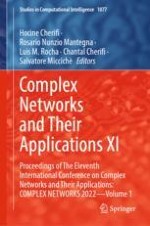2023 | Buch
Complex Networks and Their Applications XI
Proceedings of The Eleventh International Conference on Complex Networks and Their Applications: COMPLEX NETWORKS 2022 — Volume 1
herausgegeben von: Hocine Cherifi, Rosario Nunzio Mantegna, Luis M. Rocha, Chantal Cherifi, Salvatore Miccichè
Verlag: Springer International Publishing
Buchreihe : Studies in Computational Intelligence
